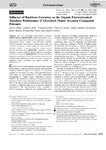Mostrar o rexistro simple do ítem
Influence of Backbone Curvature on the Organic Electrochemical Transistor Performance of Glycolated Donor–Acceptor Conjugated Polymers
| dc.contributor.author | Ding, Bowen | |
| dc.contributor.author | Kim, Gunwoo | |
| dc.contributor.author | Kim, Youngseok | |
| dc.contributor.author | Eisner, Flurin D. | |
| dc.contributor.author | Gutiérrez-Fernández, Edgar | |
| dc.contributor.author | Martín, Jaime | |
| dc.contributor.author | Yoon, Myung-Han | |
| dc.contributor.author | Heeney, Martin | |
| dc.date.accessioned | 2021-10-14T11:15:45Z | |
| dc.date.available | 2021-10-14T11:15:45Z | |
| dc.date.issued | 2021-09 | |
| dc.identifier.citation | B. Ding, G. Kim, Y. Kim, F. D. Eisner, E. Gutiérrez-Fernández, J. Martín, M.-H. Yoon, M. Heeney, Angew. Chem. Int. Ed. 2021, 60, 19679. | es_ES |
| dc.identifier.issn | 1433-7851 | |
| dc.identifier.issn | 1521-3773 | |
| dc.identifier.uri | http://hdl.handle.net/2183/28621 | |
| dc.description.abstract | [Abstract] Two new glycolated semiconducting polymers PgBT(F)2gT and PgBT(F)2gTT of differing backbone curvatures were designed and synthesised for application as p-type accumulation mode organic electrochemical transistor (OECT) materials. Both polymers demonstrated stable and reversible oxidation, accessible within the aqueous electrochemical window, to generate polaronic charge carriers. OECTs fabricated from PgBT(F)2gT featuring a curved backbone geometry attained a higher volumetric capacitance of 170 F cm−3. However, PgBT(F)2gTT with a linear backbone displayed overall superior OECT performance with a normalised peak transconductance of 3.00×104 mS cm−1, owing to its enhanced order, expediting the charge mobility to 0.931 cm2 V−1 s−1. | es_ES |
| dc.description.sponsorship | Engineering and Physical Sciences Research Council; EP/T028513/1 | es_ES |
| dc.description.sponsorship | República de Corea. Ministry of Science, ICT and Future Planning; NRF-2017K1A1A2013153 | es_ES |
| dc.description.sponsorship | República de Corea. Ministry of Science, ICT and Future Planning; NRF-2021R1A2C1013015 | es_ES |
| dc.description.sponsorship | República de Corea. Ministry of Science, ICT and Future Planning; NRF-2018M3A7B4070988 | es_ES |
| dc.description.sponsorship | República de Corea. Ministry of Science, ICT and Future Planning; NRF-2020M3D1A1030660 | es_ES |
| dc.description.sponsorship | República de Corea. Ministry of Science, ICT and Future Planning; NRF-2020M1A2A2080748 | es_ES |
| dc.language.iso | eng | es_ES |
| dc.publisher | Wiley-VCH | es_ES |
| dc.relation.uri | https://doi.org/10.1002/anie.202106084 | es_ES |
| dc.rights | Atribución 4.0 Internacional | es_ES |
| dc.rights.uri | http://creativecommons.org/licenses/by/4.0/ | * |
| dc.subject | Bioelectronics | es_ES |
| dc.subject | Conjugated backbones | es_ES |
| dc.subject | Organic electrochemical transistor | es_ES |
| dc.subject | Polymers | es_ES |
| dc.subject | Semiconductors | es_ES |
| dc.title | Influence of Backbone Curvature on the Organic Electrochemical Transistor Performance of Glycolated Donor–Acceptor Conjugated Polymers | es_ES |
| dc.type | info:eu-repo/semantics/article | es_ES |
| dc.rights.access | info:eu-repo/semantics/openAccess | es_ES |
| UDC.journalTitle | Angewandte Chemie International Edition | es_ES |
| UDC.volume | 60 | es_ES |
| UDC.issue | 36 | es_ES |
| UDC.startPage | 19679 | es_ES |
| UDC.endPage | 19684 | es_ES |
| dc.identifier.doi | 10.1002/anie.202106084 |






